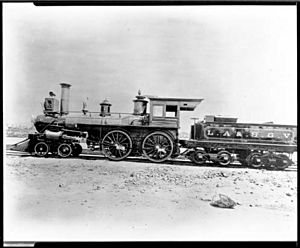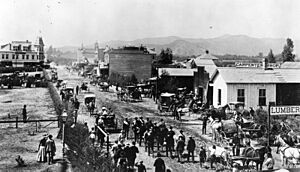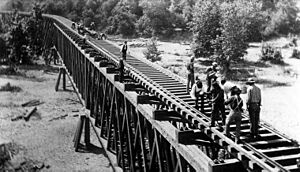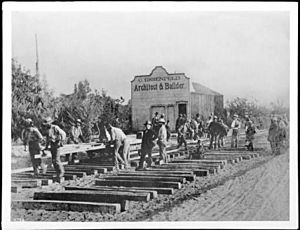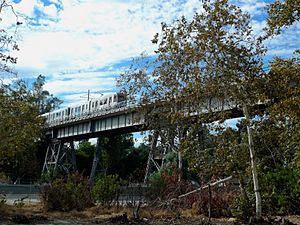Los Angeles and San Gabriel Valley Railroad facts for kids
The Los Angeles and San Gabriel Valley Railroad was a special railway company started on September 5, 1883. It was founded by a person named James F. Crank. His main goal was to build a train line that would connect Pasadena with downtown Los Angeles. This was a big deal because it made travel and trade much easier.
This railroad company was later sold on May 20, 1887. It became part of a bigger company called the California Central Railway. Then, in 1889, it joined with another company, the Southern California Railway Company. Finally, on January 17, 1906, the Southern California Railway was sold to the famous Atchison, Topeka and Santa Fe Railway. They renamed this part of the line the Pasadena Subdivision.
The original train line stopped running in 1994. But don't worry, it didn't stay closed for long! In July 2003, the railroad line was reopened. It now serves as the MTA Gold Line Light Rail service, carrying many passengers every day.
Contents
Building the Los Angeles and San Gabriel Valley Railroad
James F. Crank started the Los Angeles and San Gabriel Valley Railroad on September 5, 1883. His dream was to connect Pasadena with downtown Los Angeles by train. To get money for building the new line, the company sold shares of stock.
A wealthy man named Lucky Baldwin bought a lot of these shares. He knew that a train line would help him sell goods from his large farm, Rancho Santa Anita. This would open up new markets for his products.
Early Challenges and Successes
The Los Angeles and San Gabriel Valley Railroad had a slow start. The very first train tracks were laid in Pasadena in 1884. However, the first company hired to build the tracks went out of business by the end of 1884. This was a big setback for the project.
In January 1885, a new company took over the work. They started building the line and the second important rail bridge. A test train successfully ran on September 14 and September 16, 1885. This was a sign that the project was getting close to completion.
Grand Opening and Growth
A huge celebration was held in Pasadena on September 30, 1886. This was to mark the completion of the Los Angeles and San Gabriel Valley Railroad. The line now ran all the way from downtown Los Angeles to Lamanda Park in East Pasadena.
The train line traveled through the Arroyo Seco area to reach Pasadena. The trains crossed the Arroyo Seco just north of Garvanza in Highland Park. The first Pasadena Rail Station was a wooden building built in 1887. It was later replaced by a new station in 1934.
The new train line brought a lot of growth to Pasadena. For example, the famous Hotel Green was started in 1887 by Edward C. Webster. It was finished in 1888 by George Gill Green. Guests at the hotel could arrive directly by train at the station next door. The beautiful hotel building still stands today on South Raymond Avenue in Old Pasadena.
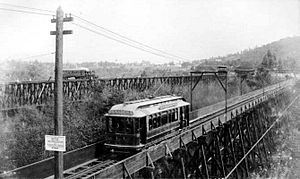
Expanding Across the San Gabriel Valley
The Los Angeles and San Gabriel Valley Railroad wanted to connect even more places. In November 1886, they began building a new line west from Mud Springs. This place is known today as San Dimas. By January 1887, the train tracks had crossed the San Gabriel River in Azusa.
The line continued to Monrovia in 1887. A wooden train station was built there. This station was later replaced by the Santa Fe Depot in 1926. In February 1887, land owners met with the railroad company to buy land. This land was needed to complete the train line through Pomona.
At the same meeting, land was given for the rail line through Claremont. A train station was also built in Pomona. There was a big discussion about what to call it.
The Railroad's Impact on Towns
The Los Angeles and San Gabriel Valley Railroad was sold on May 20, 1887. It became part of the California Central Railway. This led to a huge land boom along the new train line. In Mud Springs, this boom led to the creation of the San Jose Ranch Company. This company helped plan streets and new businesses. Soon, Mud Springs changed its name to San Dimas.
The Azusa Land and Water Company sold land in Azusa. A new town called Alosta appeared near Azusa. Another area, Southern Glendora, also grew thanks to the railroad. The Monrovia Land and Water Company sold land in Monrovia.
The new train line was also very important for farmers in the San Gabriel Valley. It helped citrus, nuts, and fruit growers get their goods to market. The original Rancho Santa Anita station from 1887 was later moved to the Fairplex's Rail Giants museum in 1969. On January 17, 1906, the Southern California Railway was sold to the Atchison, Topeka and Santa Fe Railway. This part of the line was then called the Pasadena Subdivision.
Lamanda Park Station and Its Role
Lamanda Park had its own train station for both goods and passengers. Since Lamanda Park had many citrus groves and vineyards, it also had a long side track. This track was used to ship these goods.
However, the Prohibition (when alcohol was banned) ended the wineries. The last citrus packer in Lamanda Park was the Sierra-Madre Lamanda Park Citrus Association. They packed oranges, lemons, limes, and grapefruit. Their packing house was at the corner of Walnut Street and San Gabriel Boulevard. The side track also brought lumber and later cars to local businesses.
The main line closed in 1994. But it reopened in July 2003 as the MTA Gold Line Light Rail service.
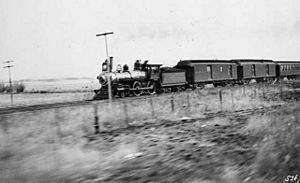
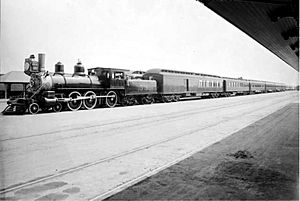
The Santa Fe Railway's Arrival
Important railroad leaders like Jay Gould and Collis Potter Huntington tried hard to keep the Santa Fe Railway out of the San Gabriel Valley. But in May 1887, the very first Santa Fe train arrived in Los Angeles. Santa Fe had an expensive agreement to use another company's tracks to run trains from Colton to Los Angeles. This agreement lasted for about a year and a half.
Connecting the Lines
When the Los Angeles and San Gabriel Valley Railroad was sold on May 20, 1887, it joined with the California Central Railway. This railway was a smaller company owned by the Atchison, Topeka and Santa Fe Railway. This connection happened at Mud Springs. It completed the train line all the way from Chicago to Los Angeles, passing through the San Gabriel Valley.
Train services like Amtrak's Southwest Chief and Desert Wind used this line. However, the Desert Wind service moved to a different line in 1986. The Santa Fe line served the San Gabriel Valley until 1994. That year, the 1994 Northridge earthquake damaged a bridge in Arcadia.
Modern Use of the Old Line
In the late 1990s, construction began on the Gold Line. This new light rail service opened on July 26, 2003. This means that the old Los Angeles and San Gabriel Valley Railroad right of way (the path where the tracks were) is still used today!
In 2013, more construction started on the old right of way for the Gold Line Foothill Extension. The site of the original 1886 Monrovia Station was part of this new construction. The line was planned to continue to the site of the old Azusa Station, which opened in 2015.
Santa Fe also built a service line just south of the main line in Pasadena. This line ran near Walnut Street from Eaton Canyon wash to Wilson Avenue. Over time, parts of this line have been sold off. You can still see the raised ground where this line used to be on Sierra Madre Boulevard. It's just north of Colorado Boulevard, near the VW dealer.
Lamanda Park had many citrus groves and vineyards. The station helped ship these goods. The Prohibition ended the wineries. The last citrus packer was Sierra-Madre Lamanda Park Citrus Association. They packed oranges, lemons, limes, and grapefruit. Their packing house was at the corner of Walnut Street and San Gabriel Boulevard. Train service to Lamanda Park ended in the 1950s. The service line that stopped at lumber yards and car dealers in Pasadena was finally abandoned in 1980.
Images for kids



